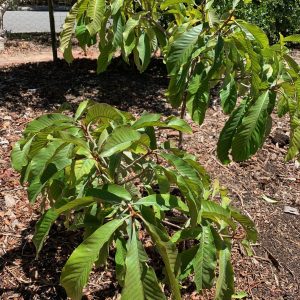Pouteria glomerata
Chicosapote, zapote, abio
Origin
Central and tropical South America, hardly known outside endemic areas. There are two sub-species: P. glomerata, ssp glomerata and P. glomerata, ssp stylosa, with the two separated on leaf characteristics.
Climate
It typically grows along river banks and areas that are regularly flooded, from 22° north to 25° south, and altitudes from sea level to 1300m. Surprisingly for a plant that’s found in these regions it has a deep tap root system giving it some drought tolerance, presumably reflecting earlier geological transitions during its evolution.
Plant Description
An evergreen tree with pale grey bark growing to 30m in its native environment, but probably much less than this in the less fertile drier conditions of the south west of WA. Sticky sap is released when injured. Leaves are borne on short petioles clustered toward the apex of branches, spirally arranged, 6-20 X 3-6cm, oblanceolate-elliptic, glabrous above and puberulous below. They turn red before abscission.
Relatives
A member of the Sapotaceae family containing about 450 species, many of these in the genus Pouteria. Other valued fruiting relatives include mamey sapote, green sapote, canistel, lucuma, sapodilla, miracle fruit and star apple.
Soils
Not studied, but as it’s found in flood prone areas drainage is obviously not a problem, and fertile river silt would be normal.
Propagation
By seeds that are recalcitrant. Germination is hypogeal cryptocotylar with a good success rate.
Cultivars
None selected and no developmental or breeding work has been undertaken.
Flowering and Pollination
Axillary or ramiflorous fascicles have 2-10 greenish-cream monoecious or dioecious flowers borne on short pedicels. They are tetramerous with 2-3mm long sepals, glabrous on the inner side. The corolla is cylindrical, glabrous and 2-4 mm long with 4 stamens attached in the lower half. Stamens are absent or small in female flowers, and the glabrous style is 1-2.5mm long. No research has been done on pollination.
Cultivation
In Perth’s dry climate, adequate watering would be required, and sandy soils should be improved.
Wind Tolerance
It normally grows amongst other trees along river banks affording some protection, less in more exposed locations.
Pruning
Probably the normal vase shape establishment when young to help contain size and let in light, with early selection of 3-4 main scaffold branches, and periodic removal of any dead or overlapping branches.
The Fruit
The globose yellowish-pale brown fruit are 2.5-9cm long with a hard pericarp that can be smooth or knobbly. There are 1-several broadly elliptic seeds 2-4cm long with a tough seed coat and a scar area covering most of the seed. Damaged immature fruit exude a white latex. Ripe fruit have high concentrations of healthy antioxidant anthocyanins.
Fruit Production and Harvesting
Seedlings may start flowering when much less than fully grown. Flowering can occur through much of the year, with trees bearing fruit in all stages of development.
Fruit Uses
The sweet fruit is mainly eaten fresh and is popular in native areas.
Pests and Diseases
In the Perth region this is unknown.
Comments
This species is under trial in our area, and it will be some time before we know whether it fares well and is worth growing in terms of fruit qualities and necessary management. Tree size should be contained and adequate water will be important. Dioecious plants will need cross-pollination either from grafts or separate trees.
